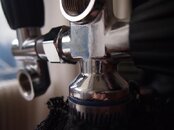broadreach
Contributor
Hi,
I'm moving to the U.S. (California) from Europe and considering bringing a European H valve with me. Since my regs are all DIN, it seems that it would be easier to just bring my (almost new) valve along rather than having to purchase a new one in the U.S. to replace the single Yoke valve that would probably come with any used tanks sourced locally.
Can anyone look at the specs of this valve and tell me if it would fit the average U.S. tank?
Markings on Valve:
3/4.14" (this is very unusual for Europe, but my tank is old)
WP 232 Bar
CE 1370
13-05/187
SOS 10126
See photo attached.
Thanks!
I'm moving to the U.S. (California) from Europe and considering bringing a European H valve with me. Since my regs are all DIN, it seems that it would be easier to just bring my (almost new) valve along rather than having to purchase a new one in the U.S. to replace the single Yoke valve that would probably come with any used tanks sourced locally.
Can anyone look at the specs of this valve and tell me if it would fit the average U.S. tank?
Markings on Valve:
3/4.14" (this is very unusual for Europe, but my tank is old)
WP 232 Bar
CE 1370
13-05/187
SOS 10126
See photo attached.
Thanks!





